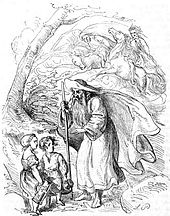Faithful Eckart and Tannhauser
Faithful Eckart and Tannenhäuser (sic) is a two-part story by the romantic Ludwig Tieck . It appeared in Romantic Poems in 1799 and in Phantasus in 1812 .
content
Faithful Eckart saves the life of Duke Burgundy in a battle and loses his son for him. The Duke rewards him, but later distrusts him because of his high reputation, which he envies. He takes his second son prisoner and also the youngest who came to him to change his mind. In search of his sons, Eckart meets an old man whose children were lured to the Venusberg by a devilish minstrel. Then Eckart learns that his sons are dead. He goes to the Duke, nobody dares to stop him, but he renounces revenge. Eckart seeks death in the forest and regrets his generosity. Burgundy fears him and wants to kill him, but is separated from his entourage by a storm. Eckart hears his cries for help and carries him to a house that Burgundy's newcomer spied from a fir tree. The dying duke therefore calls the squire Tannenhäuser, gives him two castles and makes Eckart the guardian of his sons. When the music lures her to the Venusberg, Eckart saves her and dies in the process.
Tannenhäuser, son of the imperial council and his friend Friedrich, live over 400 years later. Tannenhäuser suddenly disappears without a trace. Years later he returns to Friedrich as a pilgrim with a wild look. At first he doesn't want to say where he was. Then he tells how all his life he felt incomprehensible inner desires and at night fearful dreams about his parents. He fell in love with Emma, daughter of a house with beautiful flowers. When she preferred someone else, he killed him, whereupon Emma, then his parents, died of grief. At night he climbed a mountain and called the devil, who taught him a song that led him to Mount Venus. He passed Eckart, who was guarding the entrance, and indulged inside in pagan lust. Now he wants to go to the Pope for absolution. When Friedrich introduces his living wife Emma to him, Tannenhäuser believes he has been deceived by the madness and leaves. He comes one night, says the Pope cannot forgive him, and kisses Friedrich. He stabbed Emma. From the kiss Friedrich has to follow him to the mountain.
Language and style
The story begins as a heroic saga with a flowing transition into legends and fairy tales. The dramatic passages of the first part are told in verse, which underlines that it is already legend for the characters of the second part.
Tieck divides the world into Christianity and paganism banned into hell. The former is characterized by flowers, mortal happiness, fertile earth and light, the latter by underground mineral, colors and tones. In character there is a contrast between the fearful prince, who projects his own vices onto others, and the pious, who observes his inner feelings and therefore always remains loyal and only wants to be recognized as loyal.
Motive comparisons
The name of Duke Burgundy, who cowardly betrays his brave friend, obviously takes up the Nibelungen saga . Possible model: The Trew Eckart of Georg Wickram . The second part is apparently based on the Tannhauser legend .
The delusional game of confusion in which a familiar person suddenly portrays his own secret guilt is already central in Tieck's first story, The blonde Eckbert . He takes up the idea of the Venusberg and the contrast between minerals and the plant kingdom in his story Der Runenberg .
On the minstrel cf. Pied Piper of Hamelin and Grimm's fairy tale The whimsical minstrel . The house in the dark forest, the light of which can be seen from afar, appears in many fairy tales, e.g. B. The glass coffin .
literature
- Marianne Thalmann: Ludwig Tieck. The fairy tale from Phantasus. Dramas. Wissenschaftliche Buchgesellschaft, Darmstadt 1978, pp. 27-58, pp. 892-893.
- Christian Begemann: Eros and Conscience. Literary psychology in Ludwig Tieck's short story “Der getreue Eckart and the Tannenhäuser” . In: International Archive for the Social History of German Literature 15.2 (1990), pp. 89–145.
